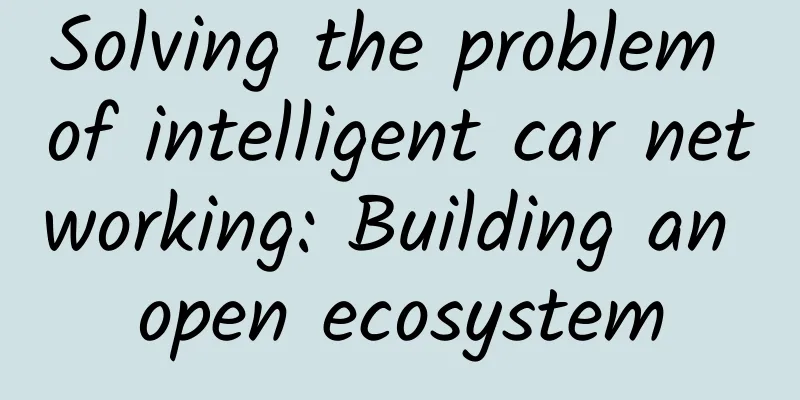Solving the problem of intelligent car networking: Building an open ecosystem

|
my country's intelligent connected vehicles (driverless cars) are accelerating. Recently, the Guangzhou Municipal Transportation Commission officially released the "Guiding Opinions on Road Testing of Intelligent Connected Vehicles in Guangzhou (Draft for Comments)" (hereinafter referred to as the "Draft"). Previously, cities such as Beijing, Shanghai, Chongqing, and Shenzhen have all released relevant road testing details. This means that intelligent connected vehicles have been deployed in more and more cities and will be officially put on the road in cities in the future. When it comes to intelligent connected cars, there are always two parts involved. One is the intelligent evolution of car terminals, and the other is the change in traffic patterns. "Based on the new generation of artificial intelligence, big data, and cloud computing technologies, future transportation can achieve true intelligence. It is a large ecosystem." Li Keqiang, a professor at the Department of Automotive Engineering at Tsinghua University, pointed out on the topic of intelligent connected cars. The formation and maturity of the intelligent transportation ecosystem means that industry breakthroughs can only be achieved after a series of breakthroughs in related technical systems, industrial ecological systems, etc. "Including high-precision map basic data platforms, cloud control basic platforms, intelligent vehicle terminal computing platforms, etc., an ecosystem needs to be established to achieve relevant breakthroughs." Li Keqiang said. Networking Communications According to the "2017 Internet of Vehicles White Paper" by the China Academy of Information and Communications Technology, the key technologies of the Internet of Vehicles are distributed at the three levels of "end-pipe-cloud". Among them, the "end" level includes the acceleration of the intelligentization and networking of vehicles and roadside facilities, and the key technologies include automotive electronics and vehicle operating system technology; the key technologies at the "pipe" level include 4G/5G vehicle cellular communication technology, LTE-V2X and 802.11p direct wireless communication technology, and direct V2X wireless communication technology is currently the focus of competition among all parties. The core of the "cloud" includes the Internet of Vehicles platform technology that supports connection management, capability opening, and data management and multiple services. "The sensors (on the vehicle terminals) are equivalent to human eyes. In addition to eyes, we often need ears and mouths for perception." Ren Shiyan, director of the Internet of Vehicles product line of Datang Telecom Technology Industry Group, explained, "So communication actually brings a new perception channel. Through the broadcasting, sending and receiving of information, it can achieve beyond-line-of-sight coverage. Such coverage can make vehicle perception safer and more reliable." In fact, the intelligent transportation ecosystem formed by adding "ears" and "mouths" to a single vehicle is the "advanced state" of the Internet of Vehicles. In this state, vehicle-road information can be acquired based on wireless communication, sensor detection and other technologies. Through the interaction and sharing of information between vehicles and between vehicles and roads, intelligent coordination and cooperation between vehicles and infrastructure can be achieved, thereby achieving the goal of optimizing the use of system resources, improving road traffic safety, and alleviating traffic congestion. In terms of "pipe" technology, direct-connection mode V2X wireless communication technology has entered a critical period of competition. It is understood that direct-connection mode V2X wireless communication is a new communication technology proposed for the networking of cars and roads, and there is currently a dispute over the technical route. The first is DSRC (Dedicated Short Range Communications), which is a technology based on the IEEE 802.11p underlying communication protocol and the IEEE 1609 series of standards. The second is the LTE-V2X technology promoted by Chinese companies, which realizes vehicle-to-vehicle communication based on 4G technology and is a proprietary vehicle networking protocol based on LTE cellular network for V2X. In March 2017, the technology completed standardization work in the international standards organization 3GPP. Wang Zhiqin, deputy director of the China Academy of Information and Communications Technology, said earlier that my country's LTE-V2X-related standards were basically completed by the end of 2017, including LTE-V2X architecture, spectrum, air interface, network layer and application layer, security, etc. In terms of specific applications, in May this year, Wuxi City launched a major project of city-level demonstration application of Internet of Vehicles (LTE-V2X), planning three stages of large-scale application of intelligent networked vehicles, including open road testing research, city-level large-scale demonstration application, and building an Internet of Vehicles industrial base, with an implementation period from 2017 to the end of 2020. Problems to be solved V2X communication technology has become the focus of competition among various companies, but there are still many problems to be solved. When conducting research on self-driving cars with Intel, Li Keqiang said that his team will choose the innovative application of V2X in smart connected cars as a major research area, which will include three directions: establishing a unified assessment mechanism for driving risks of smart connected cars based on V2X information; realizing the organization and coordination of smart connected cars in complex traffic environments based on V2X technology; and what information quality requirements the key applications of smart connected cars have under non-ideal V2X communications. According to Li Keqiang, it is extremely difficult to judge the safety of intelligent connected vehicles, and this difficulty is further increased in China's complex traffic scenarios. "We want to see if we can use the advantages of V2X and V2X communication technology to establish a unified mechanism for the safety evaluation of intelligent connected vehicles under truly complex working conditions." This involves the study of driving safety zone theory and its application, including applicability improvement, practical calibration methods, and safety assessment applications. The second is the organization and coordination of intelligent connected vehicles in complex traffic environments. In fact, after V2X technology can realize multi-vehicle connection, building the organization mode, connection mode and coordination of vehicle queues has also become an important proposition, which involves basic issues such as modeling and control selection of complex systems. "We chose the scenario of smart cars passing through intersections without traffic lights. The simplest method is to use dotted line queuing for multi-mode organization, use communication topology for recombination, build an intersection conflict model, avoid conflicting geometric structure configurations, and how to design the controller of the distributor in this case," Li Keqiang introduced. In addition, since the current road vehicles are mainly traditional vehicles, in the transition to the "advanced state" of the intelligent transportation ecosystem where vehicles communicate with each other and with the road, it is inevitable that intelligent vehicles and traditional vehicles will be mixed in the transportation mode. Traditional vehicles may not always fully comply with traffic rules. In this case, how to balance the transportation system to ensure safety? Jack Weast, senior chief engineer and chief system architect of Intel's autonomous driving solutions, said that Intel has launched the Responsibility-Sensitive Safety Model (RSS), which embeds human judgment standards in complex road conditions into the machine system, telling the machine how to respond in dangerous environments, thereby ensuring the safety of smart cars while driving. "In the RSS simulation test, the data formula for autonomous driving is completely set according to the human driving method and habits." Jack Weast said, "The results of the simulation test show that the driving response operation of the RSS-based autonomous driving vehicle is anthropomorphic, basically the same as that of a human driver." Ecological integration However, Jack Weast also emphasized that RSS is still in its infancy. According to Jack Weast, the three levels of traditional intelligent driving include perception, decision-making planning and action. The application of the RSS model means adding another layer between the planning and action layers. "We need to ensure the planning capabilities of the artificial intelligence foundation and ensure that it can run smoothly in the actual environment. This is a huge technical challenge for any company. It is not enough for a single company to do it alone. We need the entire industry to get involved." In fact, the participation of research and academic institutions in the industry, combined with enterprise algorithms and technologies, can further determine the safety model of smart cars, thereby improving the accuracy of the model and the safety of the vehicle. Driven by the collaborative effect, Intel recently established the Intelligent Connected Vehicle University Cooperation Research Center and signed a cooperation agreement with Tsinghua University and the Institute of Automation of the Chinese Academy of Sciences to jointly promote research on topics related to autonomous driving vehicles. "The real industrialization of intelligent connected vehicles requires a series of work, including breakthroughs in a series of technologies such as the technology innovation system, the automotive industry ecosystem, the road network facilities system, the regulations and standards system, the product supervision system, and the information security system," Li Keqiang said. Specifically, after cooperating with Intel, Li Keqiang's team can conduct joint research on V2X-related research based on Intel's accumulated foundation in 5G, cloud, FPGA and other technical modules, which will be more conducive to achieving results. The industry consensus has gradually been formed to form synergy through openness, and this synergy is not only in the field of research, but also in the field of application. In April 2017, Baidu launched the Apollo open software platform, which enables vehicle manufacturers to quickly build a complete autonomous driving system of their own by combining vehicles and hardware systems. Today, Baidu Apollo platform has "allied" more than 100 partners, including vehicle and parts manufacturers such as Ford, Daimler, BAIC, FAW, Chery, sensor and chip manufacturers such as Velodyne, Intel, NVIDIA; cloud service provider Microsoft and transportation service provider Shouqi Car-hailing, etc. Intel's global vice president and president of China Yang Xu said that Intel is currently exploring industry cooperation with SAIC, Changan Automobile, FAW Hongqi, NavInfo, Alibaba Cloud, Neusoft, etc. "It is extremely important for the entire industry to upgrade on intelligent connected vehicles and promote it together." As a winner of Toutiao's Qingyun Plan and Baijiahao's Bai+ Plan, the 2019 Baidu Digital Author of the Year, the Baijiahao's Most Popular Author in the Technology Field, the 2019 Sogou Technology and Culture Author, and the 2021 Baijiahao Quarterly Influential Creator, he has won many awards, including the 2013 Sohu Best Industry Media Person, the 2015 China New Media Entrepreneurship Competition Beijing Third Place, the 2015 Guangmang Experience Award, the 2015 China New Media Entrepreneurship Competition Finals Third Place, and the 2018 Baidu Dynamic Annual Powerful Celebrity. |
<<: Apple vs. Google: Who will be the leader in AI?
>>: Tesla fatal car accident investigation in California: Driver speeding and ignoring warnings
Recommend
How to do user recall? 10 strategies!
In fact, whether it is recalling users who have a...
Huawei sues Samsung for patent infringement; the mobile phone industry is already a "three-legged race"
On the 25th, Chinese technology giant Huawei sued...
To make Tik Tok, it is better to master these 8 content templates than to watch 10,000 popular videos
8 sets of special templates for creating Tik Tok ...
Why is the phone still not easy to use even though it has such a high performance score?
Is the performance of the mobile phone good? Just...
When optimizing to scale to multiple cores…
When optimizing to scale to multiple cores "...
The first brain-computer interface chip implanted in humans! Has "The Matrix" become a reality?
On January 30, 2024, Elon Musk posted a message o...
Tik Tok promotion and monetization operation tutorial!
This video software, which has become extremely p...
Chen Xudong: I have repeatedly asked myself what it takes to be successful at Magic Factory
Earlier this month, Zhou Hongyi gave Lenovo's...
Talking about environmental protection on a smoggy day: Why does Apple have such a "cleanliness obsession" in production?
It still has the same taste and recipe, but the c...
Can sweating also cause sunburn? 5 preventions and 3 treatments to help you solve the problem of sunburn
The scorching sun and high temperatures are a gre...
FCA's smallest North American assembly plant will close next month, and Dodge Viper production will cease
According to foreign media reports, FCA said it w...
Don't use plastic wrap like this anymore, it's toxic, harmful and may even cause cancer! 6 things to pay attention to when choosing plastic wrap
In daily life, we often use plastic wrap to wrap ...
Does your oCPC advertising really work?
oCPC is now a familiar concept. You may not have ...
Do you only know the funnel model for conversion rate analysis? You can also use these
What is a conversion? 1. Conversion rate Let’s ta...
Children's English must be learned for 3-12 years old, so that children can speak fluent English with confidence
Children's English must be learned for 3-12 y...









